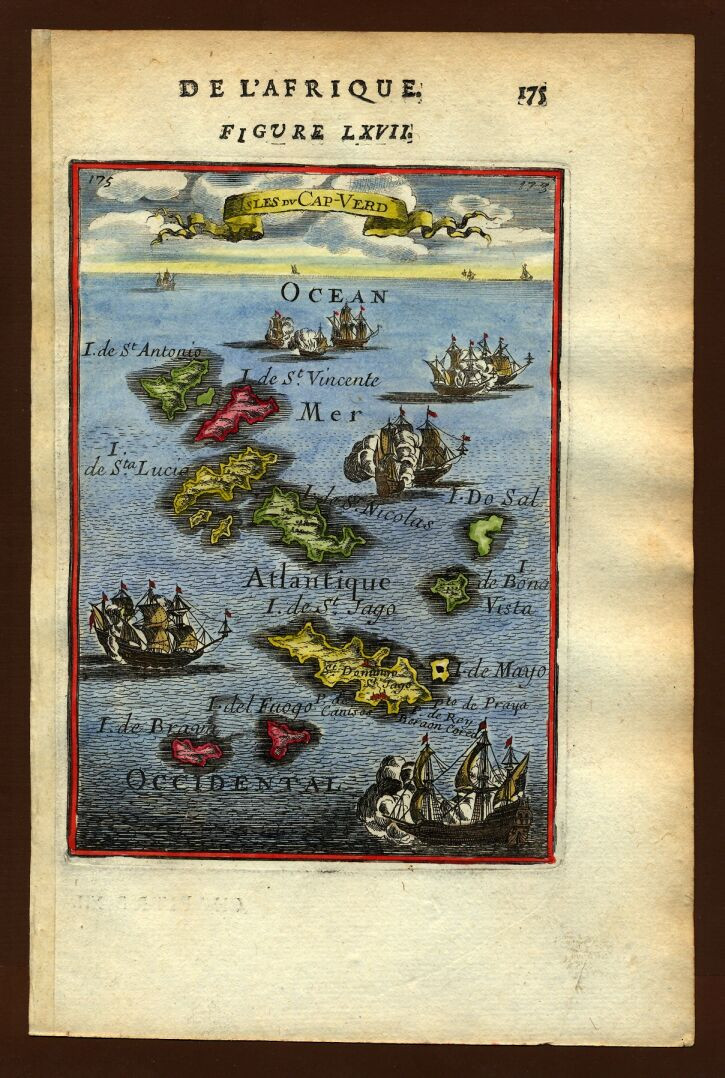D450ICV Special event station will be active from Mindelo, Sao Vicente Island, IOTA AF - 086, Cabo Verde.
They will be active on HF Bands from D4C Contest Station.
QSL via MONTEVERDE CONTEST CLUB, Pregassona 6963, Switzerland.
Information from their QRZ page:
SPECIAL ACTIVITY CELEBRATING THE 50th ANNIVERSARY OF INDEPENDENCY OF CABO VERDE.
IN COLLABORATION WITH LOCAL AUTHORITIES.
map dated 1683
CABO VERDE MILESTONES ON THE ROAD TO BE INDEPENDENT:
The Independence of Cape Verde (1975)
Cape Verde, an archipelago off the west coast of Africa, was a Portuguese colony for over 500 years. The journey to independence was deeply intertwined with the broader anti-colonial movement in Africa, particularly in Portuguese-speaking countries.
Colonial Rule and Early Nationalism
Cape Verde was colonized by Portugal in the 15th century and became an important hub in the Atlantic slave trade. Over the centuries, the islands developed a unique Creole culture, blending African and European influences. However, colonial rule was marked by economic hardship, social inequality, and discrimination against the local population.
The push for independence in Cape Verde gained momentum in the mid-20th century, inspired by similar movements across Africa. The Portuguese dictatorship, led by António Salazar, refused to grant independence to its colonies, which led to armed resistance.
The Role of PAIGC
The African Party for the Independence of Guinea and Cape Verde (PAIGC, Partido Africano para a Independência da Guiné e Cabo Verde), founded in 1956 by Amílcar Cabral, played a crucial role in the struggle for independence. Although the main focus of the PAIGC was Guinea-Bissau, it sought the liberation of both Guinea-Bissau and Cape Verde, viewing them as politically and culturally linked.
Unlike Guinea-Bissau, where the PAIGC led an armed struggle, Cape Verde saw less direct fighting. However, Cape Verdeans contributed significantly to the independence movement, often serving as PAIGC leaders, intellectuals, and diplomats.
Portuguese Revolution and Path to Independence
The turning point came in April 1974, when the Carnation Revolution in Portugal overthrew the dictatorship. The new Portuguese government began negotiations with its colonies to grant them independence. After discussions between the PAIGC and Portugal, Cape Verde was granted independence peacefully on July 5, 1975.
Post-Independence and Nation-Building
Aristides Pereira, a leading PAIGC figure, became Cape Verde's first president. Initially, Cape Verde and Guinea-Bissau considered unification, but this idea was abandoned after a military coup in Guinea-Bissau in 1980. Cape Verde instead pursued a stable democratic path, eventually adopting a multi-party system in 1991.
Legacy of Independence
Cape Verde's independence marked a significant achievement in African decolonization. Today, it is known for its political stability, economic progress, and strong democratic institutions, distinguishing it from many post-colonial nations in Africa.

They will be active on HF Bands from D4C Contest Station.
QSL via MONTEVERDE CONTEST CLUB, Pregassona 6963, Switzerland.
Information from their QRZ page:
SPECIAL ACTIVITY CELEBRATING THE 50th ANNIVERSARY OF INDEPENDENCY OF CABO VERDE.
IN COLLABORATION WITH LOCAL AUTHORITIES.
map dated 1683
CABO VERDE MILESTONES ON THE ROAD TO BE INDEPENDENT:
The Independence of Cape Verde (1975)
Cape Verde, an archipelago off the west coast of Africa, was a Portuguese colony for over 500 years. The journey to independence was deeply intertwined with the broader anti-colonial movement in Africa, particularly in Portuguese-speaking countries.
Colonial Rule and Early Nationalism
Cape Verde was colonized by Portugal in the 15th century and became an important hub in the Atlantic slave trade. Over the centuries, the islands developed a unique Creole culture, blending African and European influences. However, colonial rule was marked by economic hardship, social inequality, and discrimination against the local population.
The push for independence in Cape Verde gained momentum in the mid-20th century, inspired by similar movements across Africa. The Portuguese dictatorship, led by António Salazar, refused to grant independence to its colonies, which led to armed resistance.
The Role of PAIGC
The African Party for the Independence of Guinea and Cape Verde (PAIGC, Partido Africano para a Independência da Guiné e Cabo Verde), founded in 1956 by Amílcar Cabral, played a crucial role in the struggle for independence. Although the main focus of the PAIGC was Guinea-Bissau, it sought the liberation of both Guinea-Bissau and Cape Verde, viewing them as politically and culturally linked.
Unlike Guinea-Bissau, where the PAIGC led an armed struggle, Cape Verde saw less direct fighting. However, Cape Verdeans contributed significantly to the independence movement, often serving as PAIGC leaders, intellectuals, and diplomats.
Portuguese Revolution and Path to Independence
The turning point came in April 1974, when the Carnation Revolution in Portugal overthrew the dictatorship. The new Portuguese government began negotiations with its colonies to grant them independence. After discussions between the PAIGC and Portugal, Cape Verde was granted independence peacefully on July 5, 1975.
Post-Independence and Nation-Building
Aristides Pereira, a leading PAIGC figure, became Cape Verde's first president. Initially, Cape Verde and Guinea-Bissau considered unification, but this idea was abandoned after a military coup in Guinea-Bissau in 1980. Cape Verde instead pursued a stable democratic path, eventually adopting a multi-party system in 1991.
Legacy of Independence
Cape Verde's independence marked a significant achievement in African decolonization. Today, it is known for its political stability, economic progress, and strong democratic institutions, distinguishing it from many post-colonial nations in Africa.


Comment